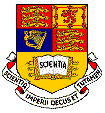Imperial
College OF SCIENCE, TECHNOLOGY
AND MEDICINE
University of London
Department of Electrical &
Electronic Engineering
Electrical & Electronic Eng.
(EEE) BEng, MEng 2nd Year
Information Systems Eng. (ISE) BEng,
MEng 1st Year
Introduction to Computer Systems
(2001-2)
Peter Y. K. Cheung
George Constantinides
|

|
Objectives
At the end of the course, students should know: how computers work; how to
evaluation their performance; the instruction set architecture of a typical
modern RISC processor; MIPS and ARM processor architectures; relationship between
hardware and software; memory interface and hierarchy; computer interfacing.
Contents
- Introduction: overview; performance.
- Instructions: formats, representations, interface with software.
- Arithmetic: number representation; hardware for arithmetic operations;
Arithmetic Logic Unit.
- Datapath and control unit: single-cycle and multiple-cycle implementations;
microprogramming; exception handling.
- Memory hierarchy: caches, virtual memory.
- Pipelining: pipelined datapaths, data and branch hazards, exceptions.
- MIPS and ARM processor architectures.
Reading
- Course textbook: ARM
System-on-Chip Architecture, 2nd Ed., Steve Furber, 2000 (around £30)
- Course textbook: Computer
Organization and Architecture (5th edition) by William Stallings
- Course textbook:
Computer Organization and Design (Second Edition) by D.A. Patterson and
J.L. Hennessy, Morgan Kaufmann Publishers, 1998, ISBN 1-55860-491-X
- corrections: see
errata
- background material not covered by course: Chapter 1 and Appendix B of
textbook
- material covered by course selected from: Chapters 2, 3, 4, 5, 6, 7, and
Appendix C of textbook
Autumn Term - Computer Architectures
& Systems
Lecture 1 Introduction to Computer Architecture
& Systems
Lecture 2 Number Systems ....................................
Lecture 3 A Very Simple Processor .......................
Lecture 4 Introduction to the ARM processor
........
Lecture 5 Assembly Language Programming .........
Lecture 6 More Assembly Language Programming
Lecture 7 Stacks and Subroutines
Lecture 8 ARM Processor Organisation
Lecture 9 ARM Instruction Set Architecture
Lecture 10 Cache Memory
Lecture 11 Exceptions and Interrupts
Lecture 12 System Buses
Problem Sheets 1 to 6 with Solutions
Lab 1 Learning ARM SDT (System Call
Summary, PFE editor)
Assessed Assignment & Notes
on Bubble Sort & Data file (turing.txt)
MATLAB Resource Page (Lecture notes and
assignments)
2000 Exam & Solution
2001 Exam & Solution
Useful ARM Documents
(They are very long!)
ARM instruction set Quick Reference Card (3 pages)
ARM Programming Techniques - Tells you all about
how to program ARM processor (258 pages)
ARM Reference Manual for Software Development Kit (v2.02)
and (v2.2) (both around 4Mbytes)
ARM Windows User's Manual for version 2.02 (1Mbytes)
and version 2.2 (9.6Mbytes)
ARM SDK version 2.02u
(for student use only, you must register this with ARM)
Useful links
- An excellent online tutorial on Number
Systems
- A link about ARM assembly
language
- ARM Education - SDT
version 2.02
- The best student
support site I know for computing
- A good cite on CPU
and RAM.
- the
future of microprocessor,
Pentium II factsheet,
GHz microprocesor,
GHz FPGA, million
gate FPGA, IRAM
SPEC
- information from textbook publisher
- Composing
Good HTML, W3C's
style guide for online hypertext, Introduction
to HTML, How to Write
HTML Files, The
HTML Quick Reference Guide, A
Beginner's Guide to HTML
This page maintained by Peter Cheung
Last updated:28 Jan., 2002.
